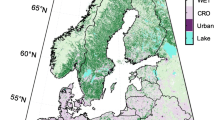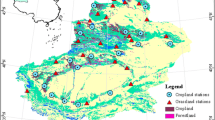Abstract
Plant phenology is a key link for controlling interactions between climate change and biogeochemical cycles. Satellite-derived normalized difference vegetation index (NDVI) has been extensively used to detect plant phenology at regional scales. Here, we introduced a new vegetation index, plant senescence reflectance index (PSRI), and determined PSRI-derived start (SOS) and end (EOS) dates of the growing season using Moderate Resolution Imaging Spectroradiometer data from 2000 to 2011 in the Inner Mongolian Grassland. Then, we validated the reliability of PSRI-derived SOS and EOS dates using NDVI-derived SOS and EOS dates. Moreover, we conducted temporal and spatial correlation analyses between PSRI-derived SOS/EOS date and climatic factors and revealed spatiotemporal patterns of PSRI-derived SOS and EOS dates across the entire research region at pixel scales. Results show that PSRI has similar performance with NDVI in extracting SOS and EOS dates in the Inner Mongolian Grassland. Precipitation regime is the key climate driver of interannual variation of grassland phenology, while temperature and precipitation regimes are the crucial controlling factors of spatial differentiation of grassland phenology. Thus, PSRI-derived vegetation phenology can effectively reflect land surface vegetation dynamics and its response to climate change. Moreover, a significant linear trend of PSRI-derived SOS and EOS dates was detected only at small portions of pixels, which is consistent with that of greenup and brownoff dates of herbaceous plant species in the Inner Mongolian Grassland. Overall, PSRI is a useful and robust metric in addition to NDVI for monitoring land surface grassland phenology.







Similar content being viewed by others
References
Alward RD, Detling JK, Milchunas DG (1999) Grassland vegetation changes and nocturnal global warming. Science 283(5399):229–231. doi:10.1126/science.283.5399.229
Busetto L, Colombo R, Migliavacca M, Cremonese E, Meroni M, Galvagno M, Rossini M, Siniscalco C, Morra Di Cella U, Pari E (2010) Remote sensing of larch phenological cycle and analysis of relationships with climate in the Alpine region. Glob Change Biol 16:2504–2517. doi:10.1111/j.1365-2486.2010.02189.x
Castro KL, Sanchez-Azofeifa GA (2008) Changes in spectral properties, chlorophyll content and internal mesophyll structure of senescing Populus balsamifera and leaves. Sensors 8(1):51–69. doi:10.3390/s8010051
Chen X, Li J (2009) Relationships between Leynus chinensis phenology and meteorological factors in Inner Mongolia grasslands (in Chinese). Acta Ecol Sin 29:5280–5290. doi:10.3321/j.issn:1000-0933.2009.10.014
Chen X, Pan W (2002) Relationships among phenological growing season, time-integrated normalized difference vegetation index and climate forcing in the temperate region of eastern China. Int J Climatol 22(14):1781–1792. doi:10.1002/joc.823
Chen X, Xu L (2012a) Phenological responses of Ulmus pumila (Siberian Elm) to climate change in the temperate zone of China. Int J Biometeorol 56(4):695–706. doi:10.1007/s00484-011-0471-0
Chen X, Xu L (2012b) Temperature controls on the spatial pattern of tree phenology in China's temperate zone. Agric For Meteorol 154-155:195–202. doi:10.1016/j.agrformet.2011.11.006
Chen X, Tan Z, Schwartz MD, Xu C (2000) Determining the growing season of land vegetation on the basis of plant phenology and satellite data in Northern China. Int J Biometeorol 44(2):97–101. doi:10.1007/s004840000056
Chen X, Xu C, Tan Z (2001) An analysis of relationships among plant community phenology and seasonal metrics of Normalized Difference Vegetation Index in the northern part of the monsoon region of China. Int J Biometeorol 45:170–177. doi:10.1007/s004840100102
Chen X, Hu B, Yu R (2005) Spatial and temporal variation of phenological growing season and climate change impacts in temperate eastern China. Glob Change Biol 11(7):1118–1130. doi:10.1111/j.1365-2486.2005.00974.x
Chen X, Li J, Xu L, Liu L, Ding D (2014) Modeling greenup date of dominant grass species in the Inner Mongolian Grassland using air temperature and precipitation data. Int J Biometeorol 4(58):463–471. doi:10.1007/s00484-013-0732-1
Chmielewski F-M, Rotzer T (2001) Response of tree phenology to climate change across Europe. Agric For Meteorol 108:101–112. doi:10.1016/S0168-1923(01)00233-7
Churkina G, Schimel D, Braswell BH, Xiao X (2005) Spatial analysis of growing season length control over net ecosystem exchange. Glob Change Biol 11:1777–1787. doi:10.1111/j.1365-2486.2005.01012.x
Cole B, McMorrow J, Evans M (2014) Spectral monitoring of moorland plant phenology to identify a temporal window for hyperspectral remote sensing of peatland. Isprs J Photogramm 90:49–58. doi:10.1016/j.isprsjprs.2014.01.010
de Beurs KM, Henebry GM (2005) Land surface phenology and temperature variation in the International Geosphere-Biosphere Program high-latitude transects. Glob Change Biol 11:779–790. doi:10.1111/j.1365-2486.2005.00949.x
Delbart N, Le Toan T, Kergoat L, Fedotova V (2006) Remote sensing of spring phenology in boreal regions: a free of snow-effect method using NOAA-AVHRR and SPOT-VGT data (1982–2004). Remote Sens Environ 101(1):52–62. doi:10.1016/j.rse.2005.11.012
Delbart N, Picard G, Le Toans T, Kergoat L, Quegan S, Woodward I, Dye D, Fedotova V (2008) Spring phenology in boreal Eurasia over a nearly century time scale. Glob Change Biol 14:603–614. doi:10.1111/j.1365-2486.2007.01505.x
Editorial Board of Vegetation Map of China CAS (2001) 1:1000000 Vegetatin atlas of China. Science Press, Beijing
Fisher JI, Mustard JF (2007) Cross-scalar satellite phenology from ground, Landsat, and MODIS data. Remote Sens Environ 109:261–273. doi:10.1016/j.rse.2007.01.004
Hall DO, Scurlock JMO, Ojima DS, Parton WJ (2000) Grasslands and the global carbon cycle: modeling the effects of climate change. Cambridge University Press. doi:10.1017/CBO9780511573095.009
Henebry GM (2013) Phenologies of North American grasslands and grasses. In: Schwartz MD (ed) Phenology: an integrative environmental science, 2nd edition. pp 197–210. doi:10.1007/978-94-007-6925-0_11
Jeong S, Ho C, Gim H, Brown ME (2011) Phenology shifts at start vs. end of growing season in temperate vegetation over the Northern Hemisphere for the period 1982-2008. Glob Change Biol 17:2385–2399. doi:10.1111/j.1365-2486.2011.02397.x
Koster RD, Walker GK, Collatz GJ, Thornton PE (2014) Hydroclimatic controls on the means and variability of vegetation phenology and carbon uptake. J Clim 27(14):5632–5652. doi:10.1175/JCLI-D-13-00477.1
Kross ASE, Roulet NT, Moore TR, Lafleur PM, Humphreys ER, Seaquist JW, Flanagan LB, Aurela M (2014) Phenology and its role in carbon dioxide exchange processes in northern peatlands. J Geophys Res-Biogeo 119(7):1370–1384. doi:10.1002/2014JG002666
Linacre E (1992) Climate data and resources: a reference and guide. Routledge, London
Liu H, Tian F, Hu HC, Hu HP, Sivapalan M (2013) Soil moisture controls on patterns of grass green-up in Inner Mongolia: an index based approach. Hydrol Earth Syst Sc 17(2):805–815. doi:10.5194/hess-17-805-2013
Luo X, Chen X, Xu L, Myneni R, Zhu Z (2013) Assessing performance of NDVI and NDVI3g in monitoring leaf-unfolding dates of the deciduous broadleaf forest in Northern China. Remote Sens 5(2):845–861. doi:10.3390/rs5020845
Menzel A (2003) Plant phenological anomalies in Germany and their relation to air temperature and NAO. Clim Chang 57(57):243–263. doi:10.1023/A:1022880418362
Merzlyak MN, Gitelson AA, Chivkunova OB, Rakitin VYU (1999) Non-destructive optical detection of pigment changes during leaf senescence and fruit ripening. Physiol Plantarum 106(1):135–141. doi:10.1034/j.1399-3054.1999.106119.x
Myneni RB, Tucker CJ, Asrar G, Keeling CD (1998) Interannual variations in satellite-sensed vegetation index data from 1981 to 1991. J Geophys Res 103(D6):6145–6160. doi:10.1029/97JD03603
Penuelas J, Rutishauser T, Filella I (2009) Phenology feedbacks on climate change. Science 324:887–888. doi:10.1126/science.1173004
Piao S, Tan J, Chen A, Fu YH, Ciais P, Liu Q, Janssens IA, Vicca S, Zeng Z, Jeong S, Li Y, Myneni RB, Peng S, Shen M, Peñuelas J (2015) Leaf onset in the northern hemisphere triggered by daytime temperature. Nat Commun 6:6911. doi:10.1038/ncomms7911
Rautiainen M, Mõttus M, Heiskanen J, Akujärvi A, Majasalmi T, Stenberg P (2011) Seasonal reflectance dynamics of common understory types in a northern European boreal forest. Remote Sens Environ 115(12):3020–3028. doi:10.1016/j.rse.2011.06.005
Reed BC, Brown JF, VanderZee D, Loveland TR, Merchant JW, Ohlen DO (1994) Measuring phenological variability from satellite imagery. J Veg Sci 5:703–714. doi:10.2307/3235884
Richardson AD, Keenan TF, Migliavacca M, Ryu Y, Sonnentag O, Toomey M (2013) Climate change, phenology, and phenological control of vegetation feedbacks to the climate system. Agric For Meteorol 169:156–173. doi:10.1016/j.agrformet.2012.09.012
Schwartz MD, Liang L (2013) High-resolution phenological data. In: Schwartz MD (ed) Phenology: an integrative environmental science, 2nd edition. pp 351–365. doi:10.1007/978-94-007-6925-0_19
Shen M, Zhang G, Cong N, Wang S, Kong W, Piao S (2014) Increasing altitudinal gradient of spring vegetation phenology during the last decade on the Qinghai–Tibetan Plateau. Agric For Meteorol 189-190:71–80. doi:10.1016/j.agrformet.2014.01.003
Wielgolaski FE, Inouye DW (2013) Phenology at high latitudes. In: Schwartz MD (ed) Phenology: an integrative environmental science, 2nd edition. Springer Netherlands, Heidelberg, pp 225–247. doi:10.1007/978-94-007-6925-0_13
Xin Q, Broich M, Zhu P, Gong P (2015) Modeling grassland spring onset across the Western United States using climate variables and MODIS-derived phenology metrics. Remote Sens Environ 161:63–77. doi:10.1016/j.rse.2015.02.003
Yang X, Chen X, Luo X (2015) Ground photography verification of remote sensing-derived vegetation phenology in the Xilinguole grassland (in Chinese). Pratacultural Science 05:667–674. doi:10.11829/j.issn.1001-0629.2014-0430
Zhang X (2015) Reconstruction of a complete global time series of daily vegetation index trajectory from long-term AVHRR data. Remote Sens Environ 156:457–472. doi:10.1016/j.rse.2014.10.012
Zhang X, Goldberg MD (2011) Monitoring fall foliage coloration dynamics using time-series satellite data. Remote Sens Environ 115:382–391. doi:10.1016/j.rse.2010.09.009
Zhang X, Friedl MA, Schaaf CB, Strahler AH, Hodges JCF, Gao F, Reed BC, Huete A (2003) Monitoring vegetation phenology using modis. Remote Sens Environ 84(3):471–475. doi:10.1016/S0034-4257(02)00135-9
Zhang X, Friedl MA, Schaaf CB, Strahler AH (2004) Climate controls on vegetation phenological patterns in northern mid-and high latitudes inferred from MODIS data. Glob Change Biol 10:1133–1145
Zhou L, Tucker CJ, Kaufmann RK, Slayback D, Shabanov NV, Myneni RB (2001) Variations in northern vegetation activity inferred from satellite data of vegetation index during 1981 to 1999. J Geophys Res-Atmos 106(17):20069–20083. doi:10.1029/2000JD000115
Acknowledgments
The authors wish to thank the Meteorological Information Center of the China Meteorological Administration for providing meteorological data. This research is funded by the National Natural Science Foundation of China under Grant No. 41471033.
Author information
Authors and Affiliations
Corresponding author
Rights and permissions
About this article
Cite this article
Ren, S., Chen, X. & An, S. Assessing plant senescence reflectance index-retrieved vegetation phenology and its spatiotemporal response to climate change in the Inner Mongolian Grassland. Int J Biometeorol 61, 601–612 (2017). https://doi.org/10.1007/s00484-016-1236-6
Received:
Revised:
Accepted:
Published:
Issue Date:
DOI: https://doi.org/10.1007/s00484-016-1236-6




